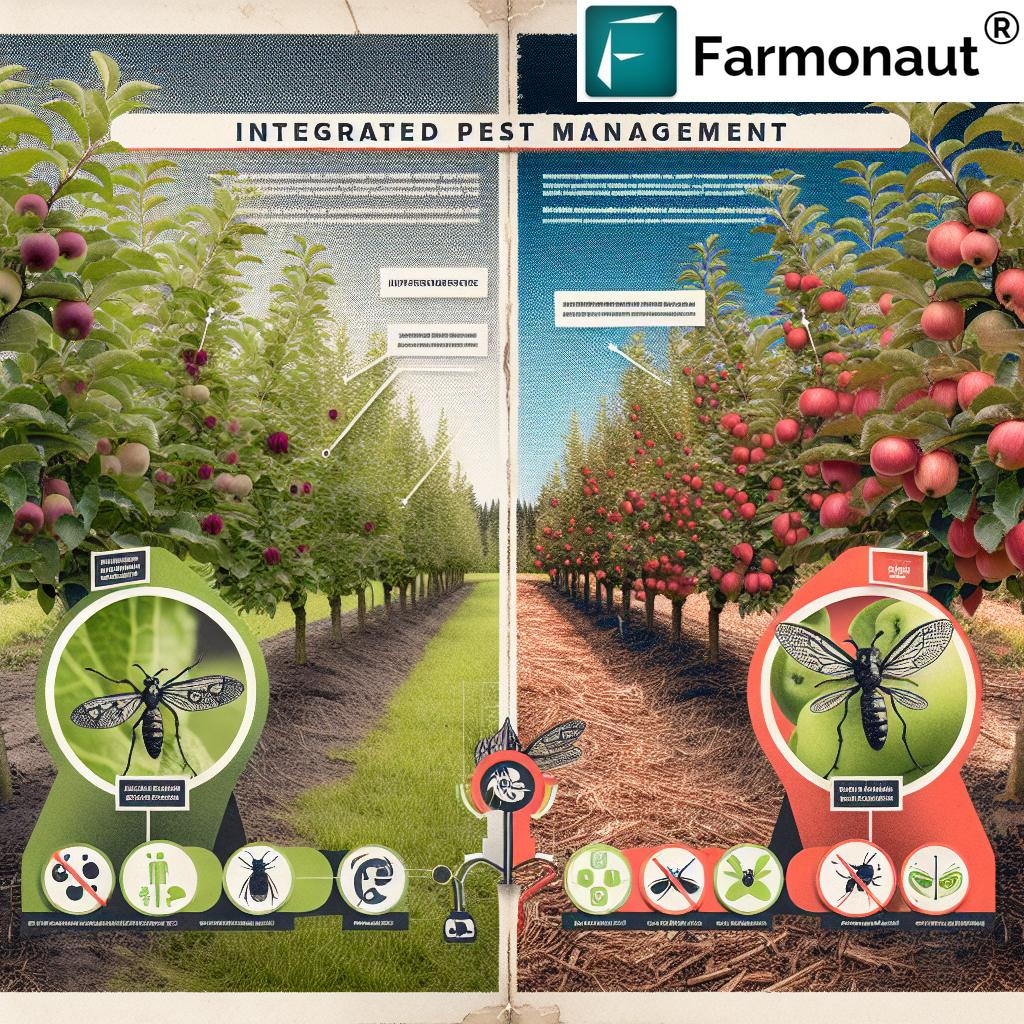Boosting Canadian Farm Efficiency: 10 Proven Strategies for Sustainable Agriculture in 2023
“Canadian farmers implementing precision agriculture tools can increase crop yields by up to 15% while reducing input costs.”
In the ever-evolving landscape of Canadian agriculture, efficiency and sustainability have become paramount for success. As we navigate the challenges of 2023, farmers across the nation are seeking innovative ways to enhance their operations, manage risks, and secure a prosperous future for their farms. In this comprehensive guide, we’ll explore ten proven strategies that Canadian farmers can implement to boost efficiency, reduce costs, and embrace sustainable practices.

1. Embracing Precision Agriculture Tools
In today’s digital age, precision agriculture tools have become game-changers for Canadian farmers. These technologies allow for more accurate and targeted farming practices, resulting in improved efficiency and reduced waste. Let’s delve into how these tools can revolutionize your farm operations:
- Satellite-based crop monitoring: Utilize advanced satellite imagery to track crop health, soil moisture levels, and growth patterns. This data-driven approach enables timely interventions and optimized resource allocation.
- GPS-guided machinery: Implement GPS technology in tractors and other farm equipment to ensure precise planting, spraying, and harvesting, minimizing overlap and reducing input costs.
- Soil sensors: Deploy sensors throughout your fields to gather real-time data on soil conditions, allowing for more informed decisions on irrigation and fertilization.
By integrating these precision agriculture tools, Canadian farmers can significantly enhance their farm efficiency strategies and make data-driven decisions that lead to improved yields and reduced environmental impact.
For those looking to harness the power of satellite-based crop monitoring, Farmonaut offers cutting-edge solutions tailored for Canadian agriculture. Our platform provides real-time insights into crop health, weather patterns, and soil conditions, empowering farmers to make informed decisions throughout the growing season.
2. Implementing Sustainable Farming Practices
Sustainability is no longer just a buzzword; it’s a necessity for long-term success in agriculture. Canadian farmers are increasingly adopting sustainable practices that not only benefit the environment but also improve farm efficiency and profitability. Here are some key sustainable farming practices to consider:
- Crop rotation: Implement diverse crop rotations to improve soil health, reduce pest pressures, and optimize nutrient cycling.
- Cover cropping: Plant cover crops during off-seasons to prevent soil erosion, enhance soil structure, and increase organic matter content.
- Integrated pest management (IPM): Adopt a holistic approach to pest control that combines biological, cultural, and chemical methods to minimize environmental impact and reduce costs.
- Water conservation: Implement efficient irrigation systems and water management practices to reduce water usage and improve crop resilience.
By embracing these sustainable farming practices, Canadian farmers can improve their agricultural risk management strategies while contributing to the long-term health of their land and the environment.
3. Optimizing Farm Operations through Data Analytics
In the digital era, data is king. Canadian farmers can leverage the power of data analytics to streamline their operations and make more informed decisions. Here’s how:
- Farm management software: Implement comprehensive farm management systems to track and analyze various aspects of your operations, from crop yields to equipment maintenance.
- Predictive analytics: Utilize historical data and machine learning algorithms to forecast crop yields, pest outbreaks, and market trends, allowing for proactive decision-making.
- Financial tracking: Implement robust financial management tools to monitor cash flow, track expenses, and identify areas for cost optimization.
By harnessing the power of data analytics, Canadian farmers can gain valuable insights into their operations, identify inefficiencies, and make data-driven decisions that boost overall farm efficiency.
Farmonaut’s advanced analytics platform offers Canadian farmers a comprehensive suite of tools for data-driven decision-making. From crop health monitoring to weather forecasting, our solution provides the insights you need to optimize your farm operations.
4. Diversifying Farm Income Streams
In today’s volatile agricultural market, diversification is key to managing risk and ensuring long-term sustainability. Canadian farmers can explore various avenues to diversify their income streams:
- Value-added products: Process and package farm products to create value-added items that can command higher prices in the market.
- Agritourism: Develop farm tours, u-pick operations, or on-farm events to attract visitors and generate additional income.
- Direct-to-consumer sales: Establish farm stands, participate in farmers’ markets, or create a CSA (Community Supported Agriculture) program to sell directly to consumers.
- Renewable energy production: Consider installing solar panels or wind turbines to generate clean energy and potentially sell excess power back to the grid.
By diversifying income streams, Canadian farmers can reduce their reliance on a single crop or market, improving their overall financial stability and resilience in the face of agricultural challenges.
“Studies show that collaborative decision-making on farms can boost problem-solving efficiency by 30% and foster innovation.”
5. Embracing Collaborative Decision-Making
The complexity of modern farming demands a collaborative approach to decision-making. By involving family members, workers, and even external experts in the decision-making process, Canadian farmers can tap into a wealth of knowledge and perspectives. Here’s how to foster collaborative decision-making on your farm:
- Regular team meetings: Schedule frequent meetings to discuss farm operations, challenges, and opportunities for improvement.
- Cross-training: Encourage workers to learn multiple aspects of the farm operation, fostering a more versatile and engaged workforce.
- Mentorship programs: Pair experienced farmers with younger or newer team members to facilitate knowledge transfer and skill development.
- External consultations: Engage with agricultural consultants, researchers, or industry experts to gain fresh perspectives on farm management.
By embracing collaborative decision-making, Canadian farmers can create a more innovative and adaptable farm environment, better equipped to handle the challenges of modern agriculture.

6. Investing in Professional Development
In the rapidly evolving world of agriculture, continuous learning and professional development are crucial for staying competitive. Canadian farmers should prioritize ongoing education and skill enhancement:
- Attend workshops and conferences: Participate in industry events to learn about the latest agricultural technologies, practices, and market trends.
- Online courses: Take advantage of e-learning platforms offering courses on farm management, sustainable agriculture, and agribusiness.
- Join farmer networks: Engage with local and national farmer associations to share knowledge, experiences, and best practices.
- Stay updated on research: Follow agricultural research publications and university extension programs to stay informed about the latest scientific findings and recommendations.
By investing in professional development, Canadian farmers can stay ahead of the curve, implement cutting-edge practices, and continuously improve their farm efficiency strategies.
Farmonaut offers regular webinars and training sessions on using our satellite-based crop monitoring tools effectively. These sessions can be an excellent opportunity for Canadian farmers to enhance their skills in precision agriculture.
7. Implementing Efficient Resource Management
Effective resource management is at the heart of farm efficiency. Canadian farmers can significantly improve their operations by optimizing the use of water, energy, and other inputs:
- Water management: Implement drip irrigation systems, moisture sensors, and smart irrigation controllers to minimize water waste and improve crop water use efficiency.
- Energy efficiency: Conduct an energy audit of your farm and implement energy-saving measures such as LED lighting, efficient heating systems, and proper insulation.
- Input optimization: Use precision agriculture tools to apply fertilizers, pesticides, and other inputs more accurately, reducing waste and environmental impact.
- Waste reduction: Implement composting systems, explore biogas production, or find innovative ways to repurpose farm waste.
By focusing on efficient resource management, Canadian farmers can reduce operational costs, minimize environmental impact, and improve overall farm sustainability.
8. Leveraging Local Peer Networks
The power of community cannot be underestimated in agriculture. Canadian farmers can benefit greatly from engaging with local peer networks:
- Farmer cooperatives: Join or form cooperatives to share resources, knowledge, and marketing opportunities.
- Peer-to-peer learning groups: Participate in or establish farmer-led learning circles to discuss challenges, share solutions, and benchmark performance.
- Equipment sharing: Explore equipment sharing arrangements with neighboring farms to reduce capital costs and improve machinery utilization.
- Collaborative marketing: Partner with other local farms to create joint marketing initiatives or develop regional branding strategies.
By leveraging local peer networks, Canadian farmers can access a wealth of practical knowledge, share resources, and create mutually beneficial partnerships that enhance farm efficiency and profitability.
9. Adopting Innovative Crop Management Techniques
Innovative crop management techniques can significantly boost yields while reducing input costs. Here are some cutting-edge approaches Canadian farmers should consider:
- Precision seeding: Utilize advanced seeding equipment to optimize plant spacing and depth, improving germination rates and crop uniformity.
- Variable rate technology (VRT): Implement VRT for fertilizer and pesticide applications, tailoring input use to specific field conditions and crop needs.
- Controlled traffic farming: Establish permanent traffic lanes in fields to minimize soil compaction and improve soil health.
- Intercropping: Explore intercropping systems to maximize land use efficiency and potentially reduce pest pressures.
By adopting these innovative crop management techniques, Canadian farmers can optimize their production systems, reduce environmental impact, and improve overall farm efficiency.
Farmonaut’s satellite-based crop monitoring can provide valuable insights for implementing these advanced crop management techniques. Our platform offers detailed vegetation health maps and growth stage analysis to support precision farming practices.
Explore Farmonaut’s API for custom integrations
10. Developing Personalized Farm Business Plans
A well-crafted, personalized farm business plan is essential for long-term success and efficiency. Canadian farmers should focus on creating comprehensive plans that address their unique circumstances:
- SWOT analysis: Conduct a thorough analysis of your farm’s strengths, weaknesses, opportunities, and threats.
- Goal setting: Establish clear, measurable, and time-bound goals for your farm business.
- Financial projections: Develop detailed financial forecasts, including cash flow projections and break-even analyses.
- Risk management strategies: Identify potential risks and develop mitigation strategies, including crop insurance and diversification plans.
- Succession planning: For multigenerational farms, incorporate succession planning to ensure smooth transitions and long-term sustainability.
By developing a personalized farm business plan, Canadian farmers can align their operations with their long-term vision, make more informed decisions, and adapt more effectively to changing market conditions.
Implementing These Strategies with Farmonaut
As we’ve explored these ten proven strategies for boosting Canadian farm efficiency, it’s clear that technology and data-driven decision-making play a crucial role. Farmonaut’s advanced agricultural technology solutions are designed to support Canadian farmers in implementing many of these strategies effectively.
Our satellite-based crop monitoring system provides real-time insights into crop health, allowing for precise management of resources and timely interventions. The AI-powered advisory system offers personalized recommendations based on your specific farm conditions, supporting sustainable farming practices and optimizing crop management techniques.
By leveraging Farmonaut’s tools, Canadian farmers can enhance their precision agriculture capabilities, improve resource management, and make more informed decisions throughout the growing season. Our platform is designed to be user-friendly and accessible, ensuring that farmers of all scales can benefit from cutting-edge agritech solutions.
Check out our API Developer Docs for advanced integrations
Conclusion
As we navigate the challenges and opportunities of Canadian agriculture in 2023, efficiency and sustainability are more important than ever. By implementing these ten proven strategies, Canadian farmers can enhance their operations, reduce costs, and build more resilient farm businesses. From embracing precision agriculture tools to developing personalized business plans, each strategy offers a pathway to improved farm efficiency and long-term success.
Remember, the journey to farm efficiency is ongoing. It requires continuous learning, adaptation, and a willingness to embrace new technologies and practices. By staying informed, collaborating with peers, and leveraging innovative solutions like those offered by Farmonaut, Canadian farmers can position themselves for success in an ever-evolving agricultural landscape.
As we look to the future, let’s commit to building a more efficient, sustainable, and prosperous Canadian agriculture sector. Together, we can overcome challenges, seize opportunities, and ensure a bright future for farming in Canada.
Farmonaut Subscriptions
FAQ Section
Q: How can precision agriculture tools improve farm efficiency?
A: Precision agriculture tools, such as satellite-based crop monitoring and GPS-guided machinery, can significantly improve farm efficiency by providing accurate data for decision-making, reducing input waste, and optimizing resource allocation. These tools enable farmers to apply inputs more precisely, monitor crop health in real-time, and make data-driven decisions that can lead to increased yields and reduced costs.
Q: What are some sustainable farming practices that Canadian farmers can implement?
A: Canadian farmers can implement several sustainable farming practices, including crop rotation, cover cropping, integrated pest management (IPM), and water conservation techniques. These practices help improve soil health, reduce environmental impact, and enhance long-term farm sustainability while often also improving efficiency and profitability.
Q: How can Canadian farmers diversify their income streams?
A: Canadian farmers can diversify their income streams by exploring options such as value-added products, agritourism, direct-to-consumer sales, and renewable energy production. These diversification strategies can help reduce reliance on a single crop or market, improving overall financial stability and resilience.
Q: What role does professional development play in farm efficiency?
A: Professional development is crucial for staying competitive in modern agriculture. By attending workshops, taking online courses, joining farmer networks, and staying updated on research, Canadian farmers can continually improve their skills, learn about new technologies and practices, and adapt to changing market conditions, all of which contribute to improved farm efficiency.
Q: How can Farmonaut’s technology help Canadian farmers improve their operations?
A: Farmonaut’s satellite-based crop monitoring system provides Canadian farmers with real-time insights into crop health, soil conditions, and weather patterns. This technology supports precision agriculture practices, enables more efficient resource management, and aids in making data-driven decisions throughout the growing season. By leveraging Farmonaut’s tools, farmers can optimize their operations, reduce input costs, and improve overall farm efficiency.
| Strategy | Potential Impact |
|---|---|
| Implementing Precision Agriculture Tools | Up to 15% increase in crop yields, 10% reduction in input costs |
| Adopting Sustainable Farming Practices | 20% improvement in soil health, 15% reduction in pesticide use |
| Optimizing Farm Operations through Data Analytics | 10-20% increase in overall farm efficiency |
| Diversifying Farm Income Streams | 25-30% increase in total farm revenue |
| Embracing Collaborative Decision-Making | 30% improvement in problem-solving efficiency |
| Investing in Professional Development | 15-25% increase in farm productivity |
| Implementing Efficient Resource Management | 20% reduction in water usage, 15% reduction in energy costs |
| Leveraging Local Peer Networks | 10-15% reduction in operational costs through resource sharing |
| Adopting Innovative Crop Management Techniques | Up to 20% increase in crop yields, 15% reduction in input costs |
| Developing Personalized Farm Business Plans | 25-30% improvement in long-term farm profitability |
















